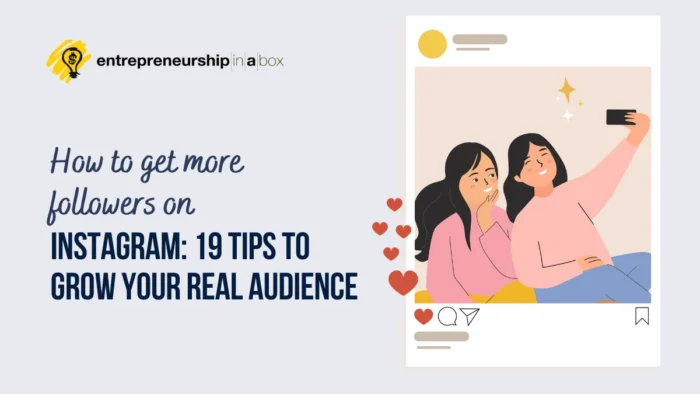Facebook marketing is essential for businesses looking to boost their online presence and drive results. With over 3.049 billion active users worldwide, Facebook provides a vast platform to connect with potential customers and build a loyal following. But with so many businesses vying for attention, how can you stand out from the crowd and create successful Facebook marketing campaigns?
In this article, we reveal the secrets to successful Facebook marketing and share valuable tips and tricks to help your business thrive on this powerful social media platform. We cover everything from optimizing your Facebook page to creating engaging content and harnessing the power of targeted advertising.
You’ll learn how to leverage Facebook’s vast array of features, such as Insights and Ad Manager, to gain valuable insights into your audience and optimize your campaigns for maximum results. We’ll also delve into the importance of building a community, developing a consistent brand voice, and measuring the success of your efforts with key metrics.
If you’re ready to take your Facebook marketing to the next level, this article is your ultimate guide to success. Let’s discover the secrets to winning the Facebook marketing game.
Why is Marketing With Facebook Important for Your Business?
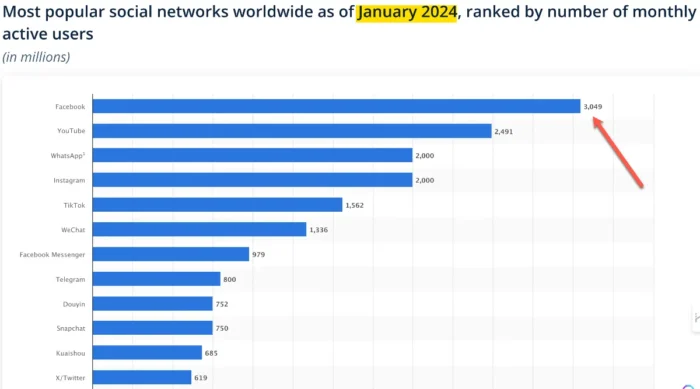
Today, Facebook is a social media platform that has become integral to people’s lives. It’s a platform to connect with friends and family and a place where companies can effectively reach their target audience. Facebook’s extensive user base and advanced targeting options make it an ideal platform for your small business.
One of the key reasons why Facebook marketing is an essential part of your social media marketing efforts is the ability to build brand awareness. Creating a Facebook Business Page will build a Facebook presence to showcase your products or services to potential customers and establish your brand identity.
With regular updates and engaging content, you can stay top of mind and build a loyal following.
Another advantage of Facebook marketing is the ability to drive website traffic and generate leads. With the right strategies, you can direct Facebook users to your website, landing pages, or online store, increasing your chances of conversions and sales.
Facebook’s advertising platform is great for your Facebook marketing campaign because it allows you to target specific demographics, interests, and behaviors, ensuring that your ads are shown to the most relevant audience.
Understand Facebook’s Algorithm and How it Affects Your Facebook Marketing Efforts
To succeed in Facebook marketing, it’s crucial to understand how Facebook’s algorithm works and how it can impact your marketing efforts. The algorithm determines which content is shown to users in their Facebook news feed based on various factors such as relevancy, engagement, and user preferences.
One of the key factors that Facebook’s algorithm considers is engagement. The more engagement your posts receive on this social media platform regarding likes, comments, and shares, the more likely they will be shown to a wider audience. This is why creating engaging and shareable content is essential to increase your organic reach on Facebook.
Another important factor on this social media platform is relevancy. Facebook aims to show users content that is most relevant to their interests and preferences. To ensure the right audience sees your content, it’s essential to understand your target audience and tailor your posts accordingly. Use Facebook Insights to gain valuable insights into your audience demographics, interests, and behaviors, and use this information to inform your content strategy.
How to Create a Facebook Marketing Strategy
Having a strong Facebook marketing strategy is important if you want to succeed on this social media platform.
Developing an effective Facebook marketing strategy requires careful planning and clearly understanding your business goals. Here are key steps to construct your strategy:
- Define Your Objectives: Start with clear, measurable goals. Whether it’s increasing brand awareness, driving traffic, or generating leads on this social media platform, your objectives will guide your actions on the platform.
- Understand Your Audience: Use Facebook’s Insights tool to analyze your existing audience or to identify your ideal customer profiles. Tailor your strategy to match their interests, behaviors, and demographic data.
- Content Planning and Creation: Plan your content calendar around your audience’s preferences, incorporating a mix of educational, promotional, and engaging posts. High-quality images, compelling videos, and interactive posts can significantly boost engagement on this social media platform.
- Optimize Your Facebook Business Page: Ensure your page reflects your brand accurately with a proper profile picture, cover photo, and an informative “About” section. Regularly update contact information and operation hours to provide a reliable customer resource.
- Engage with Your Community: Encourage interaction by responding to comments, messages, and reviews. Create polls to ask questions to stimulate dialogue and recognize loyal customers to foster a sense of community.
- Facebook Ads: Decide on a budget and utilize Facebook’s targeted advertising to reach specific segments of your audience. A/B testing different ad formats and copy can pinpoint the most effective approach for your campaign.
- Monitor and Adjust: Regularly review the performance of your marketing efforts using analytics. Look for patterns in what content performs best and adjust your strategy accordingly. Staying flexible will allow you to respond to changes in audience behavior and the Facebook algorithm.
By following these steps, your business can create a dynamic Facebook marketing strategy that reaches and resonates with your target audience, ultimately driving your desired results.
Set Up Your Facebook Business Page
Setting up a Facebook page is the first step towards successful Facebook marketing. Creating a professional and visually appealing page that effectively represents your brand is important.
Why Facebook pages for business and not profiles?
When discussing your business, it is better to start with Facebook pages because they allow your business to access a range of features that aren’t available on personal profiles. These include setting up targeted ad campaigns, accessing valuable insights into audience demographics and behavior, and using various tools for managing your page effectively.
Here are some key steps to follow when setting up your Facebook page:
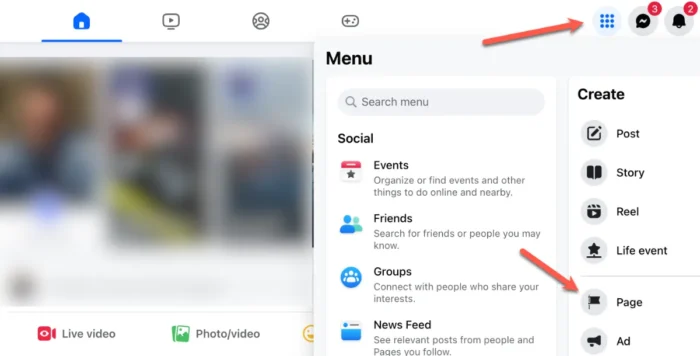
- Choose the name, right category, and short bio for your Facebook page: First, write your brand name and then select the most relevant category for your business. For example, if you are a clothing brand and have retail stores for your branded clothing, you can select “Clothing (Brand),” “Clothing store,” and “Clothing company.” Then, you can write a short bio for your page. Remember, this must be compelling because it is the first thing your Facebook audience will read after they visit your page.
- Add a compelling cover photo and profile picture: Your cover photo and profile picture are the first things users see when they visit your page, so make sure they are visually appealing and representative of your brand identity. Begin by selecting the right profile picture, ideally your company’s logo. Remember, this will be the face of your business across Facebook. Next, choose a cover photo that captures the essence of your brand and what it stands for. Make sure both images are high-resolution and fit the page’s layout perfectly.
- Customize your page tabs: Facebook allows you to customize the tabs on your page to highlight specific features or content. Choose the most relevant tabs for your business and rearrange them for easy navigation.
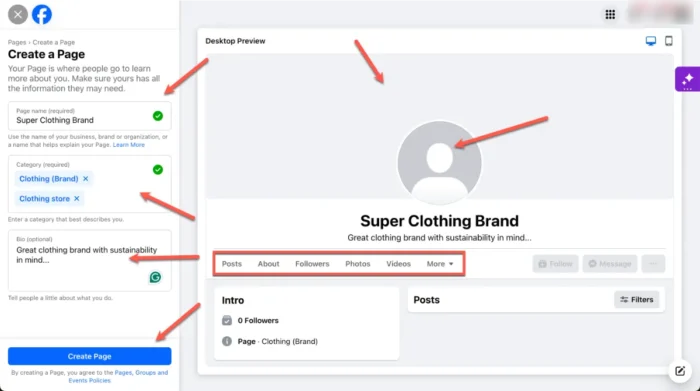
- Fill out your Facebook page information: Provide accurate and detailed information about your business, including your address, contact details, website URL, and social media links. Fill in every detail of your “About” section with concise and informative content. Use keywords your customers might search for.
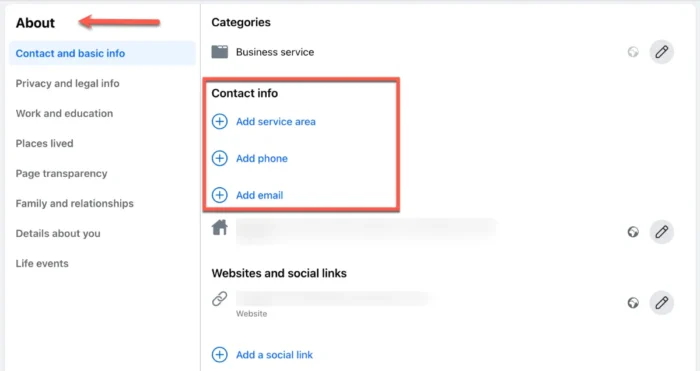
Your Facebook business page is your online storefront. It must attract and offer a smooth experience for your Facebook audience.
2. Optimize Your Facebook Business Page for Maximum Visibility and Engagement
Creating Facebook pages is not enough to reach a high level of visibility on this social media network. To reach your target audience, you must optimize your page if you want to succeed.
Here are some tips that will help you in optimizing your page to align with your Facebook marketing strategy:
- Use keywords in your page name and about section: Incorporate relevant keywords in your page name and about section to improve your page’s visibility in search results.
- Post regularly and consistently: Consistency is key in Facebook marketing. Regularly and at optimal times, share Facebook posts on your page to ensure your content reaches your audience when they are most active.
- Use eye-catching visuals: Facebook posts with visual content are more engaging and shareable than text-only posts. Use high-quality images, videos, and graphics to capture your audience’s attention and convey your brand message effectively.
- Encourage engagement: Through your Facebook posts, you can ask questions, run polls, and encourage your audience to like, comment, and share your posts. The more engagement your posts receive, the more likely they will be shown to a wider audience.
- Respond to comments and messages promptly: Engage with your audience by responding to their comments and messages in a timely manner. This shows that you value their feedback and are interested in building a relationship with them.
Create and Share Compelling Content on Your Facebook Page
Creating compelling content is crucial for capturing your audience’s attention and driving engagement on your Facebook page.
Here are some tips to help you create content that resonates with your audience:
1. Know your audience
Understand your target audience’s interests, preferences, and pain points. Create content that addresses their needs and provides value.
2. Use a mix of content formats
Experiment with different content formats like videos, images, infographics, and text-based posts. This variety keeps your content fresh and caters to different audience preferences.
Remember that your Facebook page isn’t a pitch center; it’s a conversation hub. Share content that informs, entertains, and educates. Videos, live broadcasts, how-to guides, and behind-the-scenes looks at your business can bolster engagement.
3. Use Facebook stories
Facebook stories is a feature on the Facebook platform that allows users to share photos, videos, and animations that disappear after 24 hours, similar to Instagram and Snapchat stories. The stories appear at the top of the Facebook news feed. This feature provides a new, creative way for you to share your daily experiences with your followers. Additionally, according to Facebook, 65% of people in the US say that stories help them feel closer and more up-to-date with friends.
Related: How to Get More Followers on Instagram: 19 Tips to Grow Your Real Audience
Facebook stories are a powerful way to build your Facebook presence and connect with your audience emotionally. Share personal anecdotes, customer success stories, or behind-the-scenes glimpses to connect with your audience more deeply.
4. Use compelling headlines
Like in any other social media platform, your headline is the first thing users see, so make it attention-grabbing and compelling. Use powerful words, ask questions, or bold statements to pique curiosity and encourage clicks.
5. Incorporate CTAs (Call-to-Actions)
Include clear and actionable CTAs in your posts to guide your audience toward the desired action, whether visiting your website, purchasing, or signing up for a newsletter.
Remember that your content strategy is the engine of your Facebook marketing. Without it, your page will resemble a beautifully painted car sitting idle.
6. Schedule Posts Effectively
Your content strategy must match your posting schedule with your audience’s activity. Facebook Insights can give you a good overview of when your fans are online. Consider tools like Hootsuite or Buffer to schedule posts in advance, ensuring a consistent presence.
Incorporate Different Engagement Techniques
A successful business page on Facebook is not about monologuing and only building a Facebook presence; it’s about fostering a two-way communication flow.
1. Encouraging Likes, Shares, and Comments
Be sure to engage directly with your audience when interacting with your content. Pose questions, run polls, and create shareable content that compels your followers to spread the word.
A well-designed graphic or an interesting video can encourage users to like, share, or comment on your post. Also, asking questions can be a great way to initiate a conversation and increase comments. For example, if you run a restaurant, you might ask your followers about their favorite dish from your menu.
You can also use contests and giveaways to drive significant engagement. You could ask your followers to like, share, or comment on your post to enter the contest. Additionally, you can offer incentives like discount codes, a sneak peek of a new product, or exclusive content to motivate people to engage with your posts.
Remember that when followers comment on posts you have published on your Facebook page, take the time to respond. This promotes a sense of community and encourages more people to comment.
2. Engage With Your Audience Through Facebook Groups and Messenger
Engaging with your audience is essential for building a community and encouraging meaningful relationships on Facebook.
Facebook Groups and Messenger provide powerful tools for connecting with your audience more personally. Here’s how you can leverage these features:
- Create a Facebook Group. Establish a Facebook group centered around your brand, industry, or a specific topic of interest. A well-managed Facebook group can encourage a sense of community among your target audience, provide you with valuable insights about them, and even drive sales. Here’s how to use a Facebook Group:
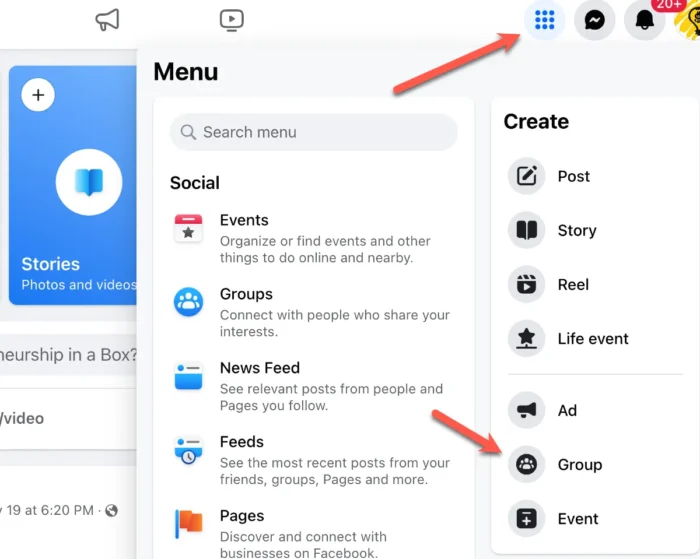
- What is Your Group’s Purpose? Firstly, define the purpose of your group. It could be a space for customers to share their experiences, ask questions, or get exclusive updates about your products or services. For example, a software company might create a group for users to share tips and tricks, while a fashion brand might create a group for customers to post outfit photos.
- Choose the right privacy setting. Depending on your goals, you may choose a “Public” or “Private” group. Public groups are visible to everyone, and anyone can join. Conversely, private groups require admin approval to join; if the admin allows, it will not be required, and only members can see posts. If you’re creating a group for customer support or for sharing exclusive content, a private group might be more appropriate.
- Invite relevant people. Invite your existing customers, followers, and other relevant people to join the group. You can do this through an email campaign, a post on your Facebook page, or by personally inviting individuals.
- Share valuable content. Sharing valuable content is key to keeping your group members engaged. This could include behind-the-scenes looks at your business, tips and advice, exclusive offers, or early access to new products. By offering something unique, you can encourage members to stay active in the group and engage with your brand.
- Encourage participation. Encourage your members to participate in the group by asking questions, creating polls, and starting discussions. The more active your members are, the more valuable your group becomes as a marketing tool.
- Monitor and moderate. Monitor your group regularly to answer questions, respond to comments, and ensure that all interactions are positive and respectful. This might require appointing a dedicated community manager.
Remember, a Facebook Group requires careful management and consistent engagement to be effective as a marketing tool. But if done right, it can strengthen your relationship with your customers and improve your brand’s reputation on Facebook.
2. Participate in Relevant Facebook Groups
Join other Facebook Groups that are relevant to your business or industry. Engage in discussions on those groups, provide valuable insights, and help other people, and in such a way, you will establish yourself and your business as an authoritative figure.
3. Use Facebook Messenger for Customer Support
Facebook Messenger is a convenient and accessible channel for providing customer support. Respond to customer inquiries, address concerns, and resolve issues promptly and personally.
Participate in relevant groups and create or attend events within your industry or community. These active engagements can lead to meaningful connections and conversions.
Utilize Facebook Advertising to Reach Your Target Audience
Today, social media advertising is one of the easiest and most effective ways to reach a target audience through Facebook advertising.
While organic reach on Facebook is valuable, utilizing Facebook ad campaigns can significantly boost your reach and help you reach your target audience more effectively.
Here are some tips for utilizing a Facebook ad campaign to its fullest potential:
1. Define your goals and target audience
Before creating a Facebook ad campaign, clearly define your goals and identify your target audience. Determine what actions you want your audience to take and create a Facebook ad that aligns with those goals.
For example, your goal can be to attract visitors to your website, blog, landing page, sales page, etc., and use Facebook ads to increase the visibility of your posts on your other people’s Facebook news feeds. Also, your goal can be increasing engagement through likes, shares, comments, or followers on your Facebook page.
2. Understand Facebook Ad Formats
Absolutely. Facebook offers a variety of ad formats to help businesses reach their specific goals. Here are the main types of Facebook ad formats:
Image Ads
Image ads are simple ads that feature a single image. They’re easy to create and can effectively attract attention and drive traffic to your website.
Video Ads
Video ads can appear in the News Feed and Stories, immersively showing your story. You can use videos to show a product in action, share customer testimonials, or tell a story about your brand.
Stories Ads
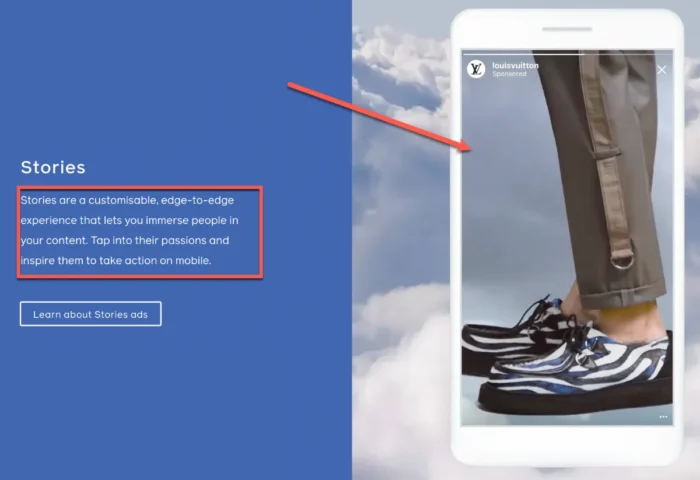
These are full-screen vertical ads that appear between stories on Facebook and Instagram. They’re designed to capture the full attention of your audience and can include images and videos.
Messenger Ads
Messenger ads appear in the Messenger app. Users can tap on an ad to take actions like downloading an app, viewing a product, or starting a conversation.
Carousel Ads
Carousel ads allow you to showcase up to 10 images or videos in a single ad, each with its own link. They’re great for highlighting different products or features or telling a story that unfolds across multiple cards.
Slideshow Ads
Slideshow ads are video-like ads made of a series of static images. They’re lightweight and load quickly, making them a good choice for reaching people with slow internet connections.
Collection Ads
Collection ads allow you to showcase a collection of products that users can browse and purchase directly from the ad. They’re a great way to create a seamless browsing and shopping experience on mobile.
Playables Ads
Playable ads provide an interactive app preview for users before downloading, helping you to find high-intent users with a try-before-you-buy experience.
Remember, the best ad format to use depends on your specific business goals and target audience. Each format has its strengths and is suited to different content and campaign objectives.
3. Understand Ad Placements
Ad placements on Facebook refers to where your ads will appear in the Facebook ecosystem, including Facebook, Instagram, Messenger, and the Audience Network.
4. Use Facebook’s Targeting Options
Facebook provides advanced targeting options that allow you to reach a specific audience based on demographics, interests, behaviors, and more. Take advantage of these options to ensure your Facebook ads are shown to the most relevant audience.
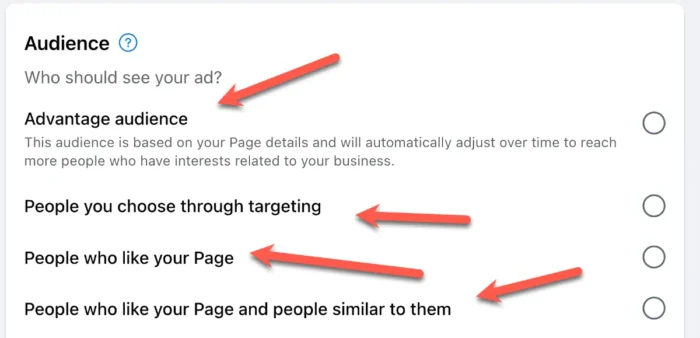
5. Create compelling ad creative
Great Facebook ads use compelling ad creative. So, your Facebook ad creative is crucial in capturing your audience’s attention. Use high-quality images or videos, compelling headlines, and clear CTAs to encourage clicks and conversions.
6. A/B Test Your Facebook Ads
Experiment with different ad variations, like ad format, creative, or CTA, to identify what works best for your audience.
Facebook Ads Manager has built-in features that make it easy to set up and run A/B tests. When you choose an existing ad campaign, click A/B Test in the toolbar and make a copy of this ad. Then, you can select the variable you want to test, like the headline, the image, the body text, the call-to-action, or any other part of your ad.Remember, testing only one element at a time is crucial to measure its impact on your ad’s performance accurately. Then, create your two ad sets – one for version A and one for version B.
Once your test has run for a sufficient period (usually at least a few days), analyze your results. Facebook provides detailed reports that help you understand which version of your ad performed better and why. Look at key metrics like click-through rate, conversion rate, and cost per action to determine the winner.
7. Monitor and Optimize Your Facebook Ads
Regularly monitor the performance of your Facebook ads and make necessary optimizations to improve results. Use Facebook’s Ad Manager and Insights to gain insights into ad performance and make data-driven decisions.
Track and Analyze Your Facebook Marketing Efforts
To measure the success of your Facebook marketing efforts, it’s essential to track and analyze key metrics. Here are some metrics you should monitor:
Reach
Measure the number of people who have seen your content. Analyze your reach to determine the effectiveness of your organic and paid campaigns.
Engagement
Monitor likes, comments, shares, and clicks on your posts. High engagement indicates that your content resonates with your audience and encourages them to take action.
Conversion rate
Track the number of conversions generated from your Facebook marketing efforts. Whether it’s website visits, purchases, or sign-ups, conversion rate provides valuable insights into the effectiveness of your campaigns.
ROI (Return on Investment)
Calculate the return on investment from your Facebook advertising campaigns. Compare the costs incurred with the revenue generated to determine the profitability of your campaigns.
Audience Insights
Utilize Facebook Insights to gain valuable insights into your audience demographics, interests, and behaviors. This data can help you refine your targeting and content strategies.
Every step of your Facebook marketing efforts should be measurable. By analyzing the data, you can only understand what works and what doesn’t.
Adjust Your Facebook Marketing Strategies Based on Data
Not getting the engagement you hoped for? Try different types of content or adjust your posting schedule. Data should inform and evolve your strategy.
Advanced Facebook Marketing Strategies and Techniques
Once you’ve mastered the basics of Facebook marketing, it’s time to explore advanced strategies and techniques to take your campaigns to the next level.
Here are some advanced Facebook marketing tactics to consider:
Retargeting
You can use Facebook’s retargeting feature to reach users who have previously interacted with your website or engaged with your content. Retargeting allows you to stay top of mind and nurture leads through personalized ads.
Lookalike audiences
Create lookalike audiences based on your existing customer base or engaged fans. Facebook’s algorithm identifies users with similar characteristics to your existing audience, allowing you to expand your reach to potential new customers.
Video Marketing
Leverage the power of video to capture your audience’s attention and convey your brand message effectively. Experiment with different video formats, such as tutorials, behind-the-scenes glimpses, or customer testimonials, to engage your audience and drive conversions. Did you know that 50% of time spent on Facebook or Instagram is spent watching videos?
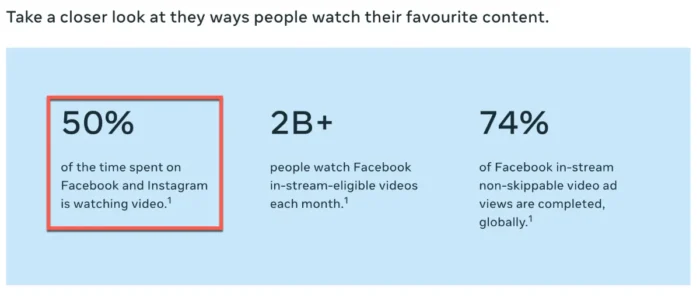
Influencer collaborations
Collaborate with influencers or industry experts to expand your reach and tap into their loyal following. Partnering with influencers allows you to leverage their credibility and reach a broader audience.
Facebook Live
Engage with your audience in real-time through Facebook Live videos. You can host Q&A sessions, product launches, or behind-the-scenes tours through Facebook Live to create a sense of exclusivity and build a deeper connection with your audience.
Conclusion
In conclusion, Facebook marketing is a powerful tool for businesses looking to boost their online presence and drive results.
Remember to stay updated with Facebook’s latest features and best practices as the platform evolves. With the right strategies and a commitment to delivering value to your audience, you can stand out from the crowd, build a loyal following, and achieve your business goals through Facebook marketing.
Facebook for businesses isn’t a puzzle with one correct answer. It’s an ongoing experiment that requires a balance of thoughtful planning, dynamic execution, and a willingness to adapt. The strategies laid out in this post are a great starting point, but the key is to continuously learn and experiment with what works for your specific business and audience.
Remember, effective Facebook marketing can drastically improve your brand recognition, lead to more loyal customers, foster community, attract new buyers, and ultimately boost sales. Be patient, authentic, and willing to learn from the data. With perseverance, your small business can turn Facebook’s vast social media into a thriving marketing platform that brings your unique value proposition to countless potential customers.



